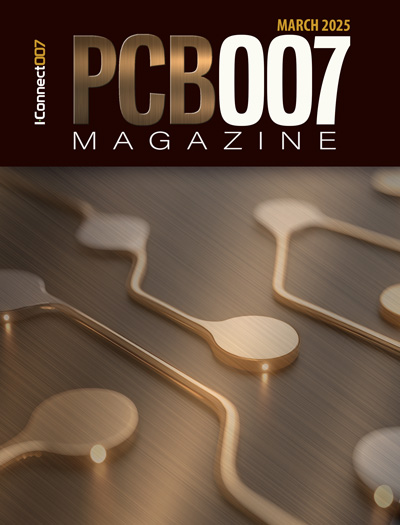-

- News
- Books
Featured Books
- pcb007 Magazine
Latest Issues
Current Issue
Voices of the Industry
We take the pulse of the PCB industry by sharing insights from leading fabricators and suppliers in this month's issue. We've gathered their thoughts on the new U.S. administration, spending, the war in Ukraine, and their most pressing needs. It’s an eye-opening and enlightening look behind the curtain.

The Essential Guide to Surface Finishes
We go back to basics this month with a recount of a little history, and look forward to addressing the many challenges that high density, high frequency, adhesion, SI, and corrosion concerns for harsh environments bring to the fore. We compare and contrast surface finishes by type and application, take a hard look at the many iterations of gold plating, and address palladium as a surface finish.

It's Show Time!
In this month’s issue of PCB007 Magazine we reimagine the possibilities featuring stories all about IPC APEX EXPO 2025—covering what to look forward to, and what you don’t want to miss.
- Articles
- Columns
Search Console
- Links
- Media kit
||| MENU - pcb007 Magazine
AT&S Wins the Airbus Avionics Supplier Award for 'Best Improvement Project'
June 16, 2023 | AT&SEstimated reading time: 2 minutes
AT&S’s long-standing customer, Airbus Avionics, chose AT&S’s copper recycling project “AERIS” as best improvement project at the 1st Airbus Avionics Supplier Day in Toulouse. AT&S process engineer, Florian Trinkl, was on stage to receive the prize stating: “This award from an important partner shows that our commitment to sustainability is valued. It was nice to receive this recognition in the name of the entire AERIS team.”
More copper, less pollution
With the implementation of an innovative and homegrown wastewater treatment process, AT&S demonstrates a new solution for sustainable resource management and recycling practices in the electronics industry: AERIS is a copper recycling system developed by AT&S to recover pure copper and chemicals from waste. The benefits are obvious: smaller demand for chemicals and copper, less waste, less CO? emission and more efficient reuse of resources.
The AERIS project was launched back in 2019 and was recently installed at AT&S’s headquarters in Leoben Hinterberg, Austria. Its infrastructure will soon enable the recovery of up to 1000 kg of pure copper per day, as well as the reuse of a significant amount of chemicals extracted from wastewater.
This comprehensive circular production makes it possible for AT&S to drastically reduce the acquisition of copper, hydrochloric acid and chemicals for wastewater treatment, whilst limiting and preventing the build-up of several tons of industrial sludge per year. AERIS reduces AT&S’s carbon footprint by 29% compared to a standard primary use of copper by minimizing the need for the expensive production and transport of valuable resources.
Through this unique and sustainable innovation, AT&S was able to register eight new patents in relation to AERIS, six of which have already been granted.
Sustainability strategy
“The implementation of AERIS is an important milestone for our sustainability strategy. We demonstrate that we are not only a technology leader in electronics but also in sustainable manufacturing. Our innovative products help to shape the future of energy, traffic and communication systems”, says AT&S CTO Peter Griehsnig.
Once the fine-tuning of the AERIS system in Hinterberg is completed, AT&S will start evaluating the roll out of similar systems for its other production plants around the world. AERIS is an important part of a broader sustainability strategy, through which AT&S has committed itself to several concrete goals that will reduce the company’s carbon footprint and deliver a path to sustainable growth.
Suggested Items
Elephantech: For a Greener Tomorrow
04/16/2025 | Marcy LaRont, PCB007 MagazineNobuhiko Okamoto is the global sales and marketing manager for Elephantech Inc., a Japanese startup with a vision to make electronics more sustainable. The company is developing a metal inkjet technology that can print directly on the substrate and then give it a copper thickness by plating. In this interview, he discusses this novel technology's environmental advantages, as well as its potential benefits for the PCB manufacturing and semiconductor packaging segments.
Trouble in Your Tank: Organic Addition Agents in Electrolytic Copper Plating
04/15/2025 | Michael Carano -- Column: Trouble in Your TankThere are numerous factors at play in the science of electroplating or, as most often called, electrolytic plating. One critical element is the use of organic addition agents and their role in copper plating. The function and use of these chemical compounds will be explored in more detail.
IDTechEx Highlights Recyclable Materials for PCBs
04/10/2025 | IDTechExConventional printed circuit board (PCB) manufacturing is wasteful, harmful to the environment and energy intensive. This can be mitigated by the implementation of new recyclable materials and technologies, which have the potential to revolutionize electronics manufacturing.
Connect the Dots: Stop Killing Your Yield—The Hidden Cost of Design Oversights
04/03/2025 | Matt Stevenson -- Column: Connect the DotsI’ve been in this industry long enough to recognize red flags in PCB designs. When designers send over PCBs that look great on the computer screen but have hidden flaws, it can lead to manufacturing problems. I have seen this happen too often: manufacturing delays, yield losses, and designers asking, “Why didn’t anyone tell me sooner?” Here’s the thing: Minor design improvements can greatly impact manufacturing yield, and design oversights can lead to expensive bottlenecks. Here’s how to find the hidden flaws in a design and avoid disaster.
Real Time with... IPC APEX EXPO 2025: Tariffs and Supply Chains in U.S. Electronics Manufacturing
04/01/2025 | Real Time with...IPC APEX EXPOChris Mitchell, VP of Global Government Relations for IPC, discusses IPC's concerns about tariffs on copper and their impact on U.S. electronics manufacturing. He emphasizes the complexity of supply chains and the need for policymakers to understand their effects.


